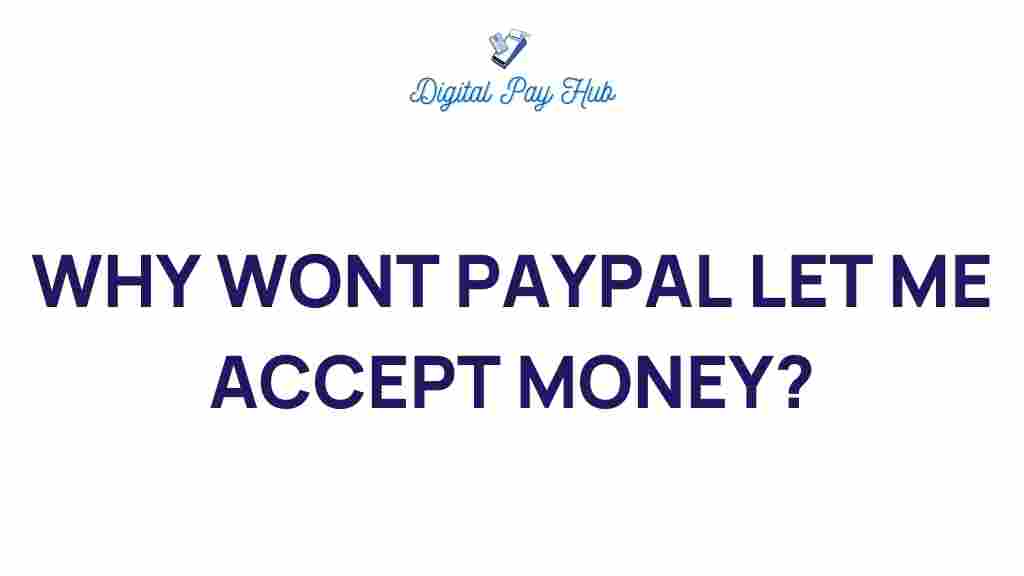Unraveling the Mystery: Why Won’t PayPal Let You Accept Money? – PayPal Issues
In today’s digital age, online transactions have become a crucial part of our daily lives, whether for personal use or business. One of the most widely used platforms for managing these transactions is PayPal. However, many users experience PayPal issues that prevent them from accepting money. This article delves into the reasons behind these issues and provides solutions for a better user experience.
Understanding PayPal and Payment Processing
PayPal is a leading financial service that allows users to send and receive money online. It serves as a digital wallet, enabling easy payment processing for personal transactions, e-commerce, and various other services. However, users may face account restrictions that hinder their ability to accept payments.
Common Reasons for PayPal Issues
There are several reasons why PayPal might not allow you to accept money. Understanding these reasons is the first step toward resolving the issue:
- Account Restrictions: PayPal may impose restrictions on accounts for various reasons, including compliance checks or suspicious activities.
- Unverified Account: If your account is not verified, you may face limitations in receiving funds.
- Payment Holds: PayPal sometimes places holds on payments to ensure security, especially for new accounts.
- Inadequate Information: Missing or inconsistent information in your account profile can lead to payment processing issues.
- Policy Violations: Engaging in activities that violate PayPal’s terms of service can result in account limitations.
- Technical Glitches: Occasionally, technical issues may temporarily prevent transactions from being processed.
Step-by-Step Process to Resolve PayPal Issues
To tackle PayPal issues effectively, follow these steps:
Step 1: Verify Your Account
Ensure that your PayPal account is verified. A verified account typically has fewer restrictions. To verify your account:
- Log in to your PayPal account.
- Go to the “Settings” menu.
- Under “Account Verification,” follow the prompts to link your bank account or credit card.
Step 2: Check for Account Restrictions
Log in to your account and check for any notifications regarding restrictions. PayPal will usually provide details on why your account has been limited and how to resolve the issue.
Step 3: Review Your Account Information
Ensure that all your account details are accurate and up-to-date. This includes:
- Your name
- Your address
- Your email address
- Your phone number
Step 4: Resolve Payment Holds
If you are facing payment holds, you can usually resolve them by:
- Completing the transaction requirements set by PayPal.
- Proving that you have delivered the service or product.
Step 5: Contact PayPal Customer Support
If you’ve tried the above steps and still face issues, contacting customer support is the best course of action. You can reach them through:
- The Help Center on the PayPal website.
- Live chat options available on your account dashboard.
- By phone, where you can speak directly to a representative.
For more detailed guidance, visit the PayPal Help Center.
Troubleshooting Common PayPal Issues
Here are some troubleshooting tips to help you manage common PayPal issues related to payment processing:
Check Your Internet Connection
A poor internet connection can lead to transaction failures. Ensure you have a stable connection before attempting transactions.
Clear Browser Cache and Cookies
Sometimes, issues stem from your browser. Clearing cache and cookies can resolve glitches:
- Go to your browser settings.
- Find options to clear browsing data.
- Select cache and cookies, then clear them.
Update Your App
If you are using the PayPal app, ensure it is updated to the latest version. App updates often fix bugs and improve performance.
Check for Server Outages
Occasionally, PayPal may experience server outages. You can check the status of PayPal services on their status page.
Conclusion: Navigating PayPal’s Financial Services
While encountering PayPal issues can be frustrating, understanding the reasons behind account restrictions and following the troubleshooting steps can help you navigate the complexities of online transactions. By ensuring your account is verified, information is accurate, and by engaging with PayPal’s customer support, you can enhance your overall user experience.
In the world of digital wallets and financial services, being proactive and informed is key to a smooth transaction process. Remember, whether you’re an individual or a business owner, resolving these issues promptly can save you time and help maintain positive relationships with your customers.
This article is in the category Payments and created by DigitalPayHub Team
